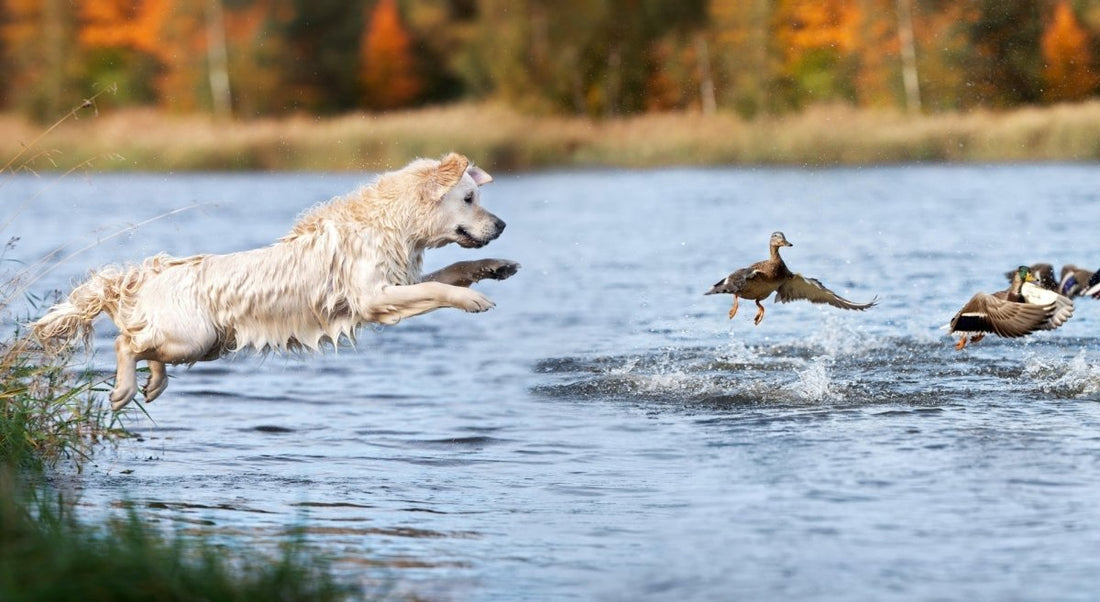You're taking a leisurely walk with your dog – and suddenly it happens. He picks up a scent, sees a rabbit or a deer, and takes off running. If this or similar situations sound familiar, you're not alone. Many dog owners often ask themselves: Why does my dog chase? And, more importantly, what can I do about it?
Why do dogs actually hunt?
Hunting behavior is genetically anchored
Your dog's hunting behavior isn't "disobedience," but rather deeply rooted in his genes and, from a dog's perspective, completely natural. Dogs are descended from wolves. Even though our dogs today tend to lead more comfortable couch potatoes, they still retain many of their primal instincts—and that includes hunting.
The hunting instinct varies in intensity depending on the dog breed. Hunting dogs , herding dogs , and even greyhounds, in particular, have been specifically selected for their hunting abilities over the centuries. It would therefore be rather strange if these dogs didn't hunt.
The hunting sequences
A dog's hunting behavior usually occurs in several phases – these are called hunting sequences . These consist of the following individual steps:
1. Locate (taking a scent or visual contact)
The dog perceives a stimulus – this can be a smell, a sound or a movement.
2. Fix
The prey is fixed on the dog and "freezes." He focuses completely.
3. Stalking
The dog sneaks up slowly and cautiously, often crouching low.
4. Rushing
The dog sprints after him – energetically and with tunnel vision.
5. Pack & Kill
In some dogs, this sequence is not pronounced. However, the impulse is still partially present.
6. Disassemble & eat
This sequence is also not shown by all dogs – since the bowl is filled regularly, there is no need for it for many dogs.
Depending on the breed, certain sequences are shown with particular emphasis. They have been specifically selected for their use. A Border Collie, for example, fixates and drives intensely. If it were to chase and kill sheep, it would quickly become unpopular. A greyhound, on the other hand, immediately begins to chase . If a rabbit leaps out of the thicket, there's no time to lose.
Why are ball games and chase games problematic?
They trigger exactly the wrong instincts
What at first glance appears to be a harmless game can have undesirable consequences in the long run. It's usually not a game at all. "Ball games" or chasing Frisbees activate the hunting sequences , especially the chase phase. So what does the dog learn? Movement = stimulus = chase!
The problem is that your dog becomes increasingly sensitive to moving stimuli – even outside of "play." Joggers, cyclists, cats, or playing children can suddenly become "prey."
Stress and adrenaline instead of relaxation
During a hunt, large amounts of adrenaline are released. While this may sound harmless at first, it makes it harder for your dog to calm down. This often leads to a kind of addictive behavior – they need more and more of it to feel "happy." If your dog is having trouble calming down, you can support them with our natural calming products .
What to do about hunting behavior
Very important: Your dog's hunting instinct cannot be trained out , but you can make it controllable and channel it in a sensible way .
1. Practice impulse control
Teach your dog not to run at every little stimulus. This can be done through exercises such as:
- Waiting at the food bowl
- Recall under distraction
- “Look at me” signals
2. Offer alternatives
Offer your dog meaningful and type-appropriate activities, such as tracking, controlled retrieving and mental stimulation.
3. Establish callback and abort signal
A reliable recall is worth its weight in gold. Train your dog regularly, first without distractions, then with a gradually increasing level of stimulation. A clear stop signal (e.g., "No," "Stop") can also be crucial in certain situations. Our delicious snacks can help you with your training.
4. Use a towline
Until your dog has mastered a reliable recall, he should be kept outside on a leash . This gives him freedom without losing control. It also prevents unwanted successes for your dog while hunting.
Myth: “Dogs need hunting as a balance”
A frequently heard phrase: “The dog needs to let off steam – hunting games are important!”
That's a misconception. Of course, a dog needs exercise and activity—but not in the form of uncontrolled hunting. Good exercise means targeted, structured training , not just mindless physical exertion.
When professional help is useful
If your dog is no longer responsive outdoors, chases game, or even attacks, you shouldn't hesitate to seek professional help. An experienced dog trainer can help you individually.
Conclusion: Understanding and training instead of frustration and punishment
Hunting behavior is not a sign of disobedience , but rather a part of a dog's natural behavior. It's important that you learn to understand it, recognize it early , and control it .
Avoid rough ball games and instead focus on meaningful exercise , impulse control , and a clear relationship between you and your dog. This will transform a potentially hunting dog into an attentive, controllable companion with whom you can once again enjoy relaxed walks.



